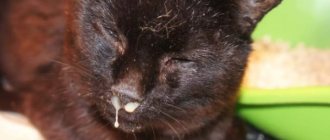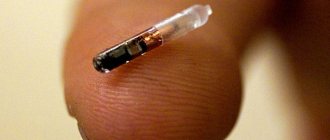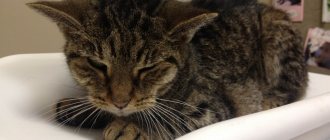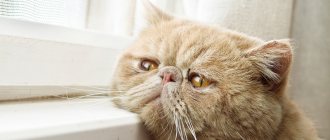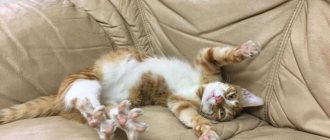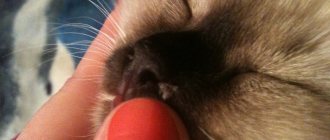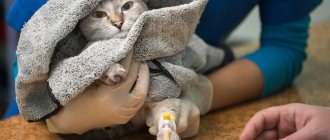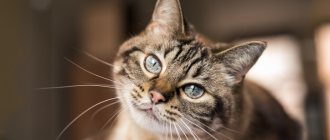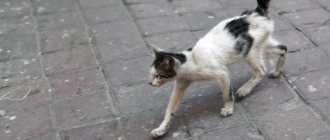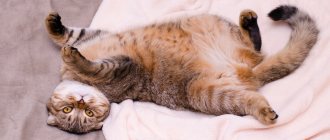The cat has pus flowing from his nose
If an animal has nasal discharge, then the pet urgently needs treatment.
Pus from a cat's nose can form due to allergies, a virus, or mechanical damage. You can find out what caused the snot from your veterinarian. Pus from the nose of a kitten or an adult cat can be of different types:
- Serous;
- Mucous;
- Mucopurulent;
- Purulent;
- Bloody;
- Bloody-purulent.
If a cat has pus flowing from its nose, which prevents it from breathing and changes its color to yellow or green, then the pet should be taken to the doctor immediately. Yellow discharge most often indicates a bacterial infection in your pet. If they have a yellowish tint, then the pet is infected with a viral infection.
Symptomatic diet and procedures
To make it easier for an animal to breathe before going to the hospital, its nasal passages must be cleared of crusts. This can be done using cotton wool and baby oil. You can soak the crusts using saline or boric acid (2% solution can be purchased at the pharmacy). The animal may resist when you help it, so you should wrap it in a blanket and hold it under your arm, or use the help of another family member.
Wet cleaning of the room and humidification of the air will help make nasal breathing easier for your animal; you can take your cat with you to the bathroom. While you take a shower or bathe, the cat will breathe moist air.
If the animal refuses to eat because it does not smell the aroma of the food, the food can be heated a little to enhance the aroma or poured with liquid from canned tuna to stimulate the animal's appetite.
It is important to provide the animal with constant access to clean water at room temperature.
In order for an ailment such as nasal discharge to occur to the animal as rarely as possible, it is important to carry out measures to generally strengthen the body. This is first of all:
- Adding active dietary supplements and vitamins to the diet.
- High-quality balanced nutrition.
- The use of general strengthening drugs, such as gamavit, immunofan, fosprenil, ibotan. Your veterinarian will help you calculate the dosage of medications.
You shouldn’t treat even the most harmless rhinitis in your pet. Frequent complications of untreated rhinitis are otitis (with subsequent complete loss of hearing), deformation of the muzzle, sinusitis, penetration of infectious agents into the brain (this condition threatens the life of the animal).
Take care of your pets, treat their illnesses on time!
Cats are most predisposed to developing a runny nose due to the congenital narrowness of their nasal passages. Even minor swelling can cause difficulty breathing. Rhinitis is especially severe in kittens.
Causes of purulent discharge
Pus is not only unpleasant, it can even interfere with breathing and swallowing. The cause of such discharge is nasopharyngeal polyps. This infection often appears in cats after treatment for inflammation of the middle ear and eustachian tube.
Discharge may appear due to neoplasms. Along with them, swelling appears, the muzzle begins to deform. Most often this happens to old animals suffering from adenocarcinoma, lymphosarcoma, fibrosarcoma, osteosarcoma.
Pus in a cat can be a symptom of a serious illness. The cause of purulent discharge may be:
- Mechanical damage to the nose with inflammation;
- Congenital pathologies such as cleft palate;
- Viral diseases (calcivirus infection or herpes);
- Toxoplasmosis;
- Entry of foreign bodies (for example, seeds);
- Panleukopenia or feline distemper;
- Chlamydial pneumonia.
If the cat has caught an infection, then discharge may also come from the eyes, the cat may sneeze and hide in a corner. You can take your temperature: if you are sick, it will be elevated.
Pus is much more serious than clear discharge and is never caused by a common cold. The disease is much more serious than a simple runny nose, and therefore you should consult a doctor. He will prescribe the right medications and dosage for your cat.
In kittens, discharge may occur for other reasons. Pus can appear from hypothermia, poor nutrition and living conditions, lack of care or early separation from the mother cat.
How a cold can harm a cat
A snotty nose in cats is a fairly common occurrence and can cause a lot of trouble for your pet. Rhinitis is an inflammation of the mucous membrane of the nasal cavity of an animal, occurring with mucous discharge, sneezing, and wheezing. In addition to the discomfort associated with loss of smell and nasal congestion, a runny nose can be the first manifestation of a serious illness.
Kitten's snot
A cat's snot appears as a response of the immune system to external stimuli. The animal's body, with the help of mucus, gets rid of foreign bodies, allergic components, dirt, pathogenic microbes and viruses. The nasal passages perform a protective function during breathing: they filter, warm and humidify the air. A sick animal is forced to breathe through its mouth. This contributes to throat and lung diseases and dehydration.
Important! Snot in a kitten occurs as a result of various pathologies. Causes may include the common cold and severe infections.
Treatment of pus
Before going to the veterinarian, you can provide first aid to the animal yourself. You can help an animal that has contracted an infection by doing the following:
You can rinse your nose from pus with solutions of boric acid (2%), zinc sulfate (1%), and saline solution. They can also be used to soak crusts;
Instillation of antiviral drops: Gamavit, Vilprofen, Maksidin, Thymogen, Anandin. You can also use baby drops, but only for one time. They eliminate only the symptoms (constrict blood vessels), without interacting with viruses and bacteria;
The use of different widow drops: antiviral and immunostimulating. There should be 2 hours between using drops of the same type.
How to put it in your nose correctly
If the veterinarian prescribes treatment, then it is the owner who should administer the drops into the cat’s nose. This should be done in the following sequence:
- Hold your pet under your armpit or have someone hold it. You can wrap it in a blanket so that the animal does not scratch anyone;
- Throw back the animal's head, tilt it slightly;
- Carefully bring the dispenser to the muzzle;
- Wait until the drops flow back, tilt your head in the other direction and repeat the same actions.
You need to instill one, maximum two drops. The animal is treated in this way for a week, but if the infection is viral, it will take longer.
Determining the cause of the leak
A veterinarian can determine why a cat’s nose is festering. It will determine the nature of the discharge. If the doctor suspects polyps or neoplasms in the nose, the pet may be sent for rhinoscopy (x-ray of the nose). It is there that the nature of the neoplasms is revealed.
Pus is a sufficiently alarming signal to contact a veterinarian. Rhinitis in humans can be cured on their own, while a cat with pus coming from the nose can only be treated by a veterinarian. Only an experienced veterinarian will be able to determine the correct dosage of medication and prescribe the correct medications to treat the problem.
IMPORTANT! VETERINARIAN CONSULTATION REQUIRED. INFORMATION FOR INFORMATION ONLY. Share with friends Article rating
Causes
Pus from the nose
Diseases in which pus is discharged from the nose are divided into contagious and non-contagious.
The following are considered contagious:
- Herpes (rinotracheitis);
- Calicivirus;
- Cat flu;
Among the diseases of non-contagious etiology, the following most often develop:
- chronic diseases and colds;
- foreign bodies;
- congenital anomalies;
- tumors.
The causes of diseases, clinical symptoms, methods of diagnosis, treatment and prevention are not the same. Let's consider each disease separately.
Herpes (rhinotracheitis)
Herpes
The disease occurs among unvaccinated cats in crowded conditions, unbalanced feeding in nurseries or shelters. Sick kittens die 10-14 days after the first signs appear. Those who have recovered become a reservoir of infection. There is a high probability of transplacental infection. The owner brings the virus into the apartment.
In addition to nasal discharge and cough, stomatitis, conjunctivitis with subsequent ulceration of the cornea, and mouth breathing develop. Constipation occurs and pregnant women abort. In the chronic course of the disease, panophthalmitis develops and the cat goes blind. An accurate diagnosis is established in the clinic.
The treatment is developed by a veterinarian. Prevention consists of timely vaccination, bringing living conditions and feeding into compliance with standards. If a cat refuses to eat for a long time, it is fed through a nasoesophageal tube. If signs of dehydration are detected, droppers with plasma substitutes are placed.
Nasoesophageal tube
When the cat begins to feed on its own, the veterinarian prescribes wet canned food or soaked granules.
Be sure to read:
What to do if your cat has difficulty swallowing food? Swallowing disorder (dysphagia) in cats
Calicivirus
Ulcerative glossitis with calcivirosis
In terms of symptoms, etiology, and pathogenesis, the viral disease resembles Herpes. A cough occurs and bronchopneumonia develops.
Distinctive features are ulcerative stomatitis and the absence of ulcerations on the cornea. Lameness appears suddenly, but disappears spontaneously after a few days. The treatment strategy and prevention are the same as for Herpes.
Cat flu
Polyvalent vaccine
Often Herpes and Calicivirus affect a pet at the same time. The disease was called cat flu. When making a diagnosis, attention is paid to the presence of signs of both diseases. A complex vaccine against calicivirus, rhinotracheitis and panleukopenia reliably protects against infection.
Cat flu is not dangerous to humans.
Why are sneezing and purulent eyes a dangerous symptom?
It is probably quite difficult for an ignorant person to imagine what is so terrible and scary about the standard process of sneezing. People can also allow themselves to sneeze a couple of times if something is preventing them from breathing. If there are no problems with the sneezing reflex, then when it comes to festering eyes, it becomes somehow uneasy. Normally, this should not happen in either cats or people. This is a truly serious deviation from the healthy state of a living organism.
In general, sneezing, as practice shows, is far from the worst symptom; the same cough can tell us about a more extensive list of ailments. But still, you should pay attention to this only if the animal sneezes for a long period of time and with noticeable force. As for eye suppuration, you need to contact a specialist immediately after it has been identified. Of course, the range of possible problems is also quite large, but they will be more serious than, for example, irritation of the nasal mucosa.
As a rule, suppuration in the eye occurs due to mechanical damage and, accordingly, inflammatory processes in the mucous membrane. But it is precisely by the same principle that an animal can suddenly start sneezing: as you know, the nose also has a mucous membrane. We pay attention to these 2 symptoms, which directly indicate to us that the pet has inflammatory processes in the body.
Chronic diseases and colds
Rhinitis occurs as a symptom of exacerbation of the following permanent diseases:
- diabetes;
- urolithiasis disease;
- renal pathologies.
Too frequent bathing leads to hypothermia and reflex swelling of the mucous membrane. Ventilating rooms freshens the air, however, cats cannot tolerate drafts and become hypothermic. In hot weather, you should not leave your pet in a room with air conditioning running, otherwise he will catch a cold.
If the disease is caused by hypothermia, and the pet’s health is satisfactory, use dual-use drops - Maxidin or Anandin. Drugs intended for humans should not be used without the approval of a veterinarian.
Congenital anomalies
Spontaneous selection leads to the birth of offspring predisposed to rhinitis. Sometimes kittens are born with a deviated nasal septum.
Hypothermia or a reaction to odors leads to reflex swelling of the mucous membrane and rhinitis. Atopic dermatitis occurs in predisposed cats over one year of age. This is a reaction to dust, smoke and odors. Along with a runny nose, cats develop cough, conjunctivitis, and skin diseases.
Be sure to read:
The cat does not drink water: reasons, daily intake, what to do, is it dangerous, how to force the animal to drink
Congenital anomalies are incurable. However, with a successfully developed therapeutic strategy, exacerbations can be stopped.
Why do a kitten's purulent eyes swell up?
There are several possible reasons for the described symptoms:
- allergy;
- chlamydia;
- mycoplasmosis;
- toxoplasmosis;
- calicivirus infection;
- herpes virus infection, etc.
To find out what infection has affected the kitten, a PRC diagnosis will be required, and only after the diagnosis has been clarified can treatment of the animal begin. You should also consider factors such as:
- time of last deworming;
- time of the last vaccination of the animal, type of vaccine;
- what additional vitamins were used to strengthen the body.
Please note that feeding a kitten with economy class food is not recommended. And we are talking about any product: both wet and dry food. It has been proven that consumption of these products by a pet provokes gastrointestinal diseases, which leads to the development of infections affecting the eyes.
Tumors
Tumor processes occur most often in older animals. As a rule, the process is characterized by the flow of pus with blood from only one nostril. The animal constantly sneezes and hits its nose with its paws. Treatment is surgery or chemotherapy.
Purulent nasal discharge is a consequence of rhinitis. A pathological symptom is not an independent disease, but a sign of an underlying illness. If the use of veterinary nasal drops does not bring the desired result, seek the help of a specialist.
Cats are vaccinated promptly in accordance with the vaccination plan. Avoid hypothermia. Buy kittens from trusted breeders with a positive reputation. Mating partners are carefully selected, since hereditary diseases are incurable.
Every cat owner is touched by the sounds made by his pet. What could be more charming than the snoring, smacking of your lips in your sleep, and even the snoring of a furry pet? However, you should not let your guard down, as some sounds, such as sniffling and grunting, may indicate the presence of serious illnesses. In what cases should measures be taken if a cat wheezes while breathing? Why might this happen?
Adviсe
List of recommendations for cat lovers:
- Having many cats in the house is great; they have a beneficial effect on their owners. But if even one of them sneezes and her eyes fester, then she needs to be isolated from everyone else.
- Periodically it is necessary to carry out preventive measures: give vitamins, medicinal herbs, make sure that there are no injuries.
- For kittens, you should wash your eyes frequently with a solution of baking soda or strong tea leaves.
- Even a small wound should be treated with hydrogen peroxide.
- Give cats anthelmintic drugs periodically.
- To strengthen the body's protective functions, you should select immunostimulants in consultation with your doctor.
If even minor deviations are detected, you should visit a veterinarian.
- Why are sneezing and purulent eyes a dangerous symptom?
- Why does a cat sneeze and her eyes fester?
- Conjunctivitis
- Allergy
- Chlamydia
- Colds
- What to do if a kitten sneezes and his eyes fester?
Of course, any normal pet owner loves his baby very much, takes good care of him and pays attention to his health. Not always cats can show any obvious symptoms of diseases known to us. But there are also signs of illness that immediately catch the eye. For example, what should we do if a kitten sneezes and his eyes fester? If the listed problems are found in an adult pet, this is already a serious cause for concern, what can we say about a small kitten?
Why can a cat sniff and grunt when breathing?
Quite often, a cat's breathing is accompanied by wheezing. As a rule, physiological factors act as the causes of this phenomenon. Such snoring should not cause concern to the pet owner.
When an animal is breathing heavily, grunting, sniffling and whistling through its nose, you should immediately show it to a veterinarian. Ignoring these symptoms caused by pathological factors can lead to serious consequences, including the death of the cat.
Natural causes
The respiratory system of these animals is similar in structure to humans. They, just like people, can sigh, sniffle, grunt, and snore. In most cases, this occurs due to natural causes and should not be a cause for concern. Your pet's wheezing may appear against the background of:
- Excessive physical activity. In healthy individuals, the respiratory rate depends on the degree of load. A cat breathes most calmly during sleep.
- Nervous shock. Experiencing excitement, fear, rage and excitement, the cat begins to breathe noisily. Breathing may be accompanied by wheezing. This is a short-term condition. It goes away after the source of stress disappears.
- Bearing offspring, feeding young and sexual desire. In all these situations, the cat's breathing quickens.
- Overheating. An overheated pet inhales air not through its nose, but through its mouth. He does it hard, with a whistle. The cat instinctively tries to spread out his whole body on the floor in the coolest room, usually on the tiles in the bathroom.
Pathological factors
Among the pathological reasons that a pet is breathing loudly are:
- Swelling of the larynx. This pathological phenomenon most often occurs against the background of an allergic reaction or foreign objects entering the respiratory system.
- Asthma. The symptoms of this disease are difficult to ignore. It is characterized by attacks of suffocation not only at night, but also during the daytime.
- Formation of stones in the organs of the urinary system. In the presence of stones, breathing is often accompanied by wheezing.
- Helminthic infestations. Worms can affect any organs, including the respiratory organs, leading to disruption of their functioning as a result of blockage.
- Inflammation of the lungs and bronchi.
- Inflammatory process in the mucous membranes of the nose.
- Respiratory diseases.
- Heart failure. In this state, the animal not only breathes poorly, but also coughs. Blueness of the mucous membranes is also noted.
- Obesity. Excess body weight leads to increased stress on all organs, including the heart muscle. The chain of pathological reactions gradually results in such phenomena as heavy breathing and snoring.
- Injuries to the chest, spine, ribs. If the animal sticks out its tongue, it is breathing shallowly, it is trying to inhale more air, as if it is suffocating, most likely, breathing is causing it pain.
A cat's eyes are festering - how and what to treat
Pets, no matter how much we care for them, also periodically suffer from various diseases and ailments.
Quite often, animals suffer from eye diseases. One of the common pathologies is suppuration of the eyes. There are many reasons why a cat's eye may be festering. It is worth understanding that after a night's sleep, dry crusts appear in the corners of the animal's eyes, which will clear up after washing the cat. But when yellowish discharge has been observed from one or both eyes for several days, your help will be needed here.
If your cat's eyes are festering, it is important to immediately find out the cause and begin treatment, as this symptom may be a sign of a serious illness.
Causes of festering eyes in cats
Purulent discharge from a cat's eyes can occur for various reasons. It is important to pay special attention when the pus is thick with a greenish or yellowish tint. Such discharge indicates deviations from the norm and may indicate severe inflammation in the body. So, let's figure out why a cat's eyes fester.
Main reasons:
- Conjunctivitis
(inflammation of the conjunctiva). This is one of the most common reasons that leads to fester in a cat’s eyes. Viral infections, allergies, and eye trauma can cause inflammation of the eye mucosa. - Blepharitis
. This is an eye disease caused by injury or a chemical burn, which is accompanied not only by purulent discharge, but also severe swelling of the eyelids. - Keratitis
. This disease is characterized by inflammation of the cornea, resulting in the appearance of tears mixed with pus. - Chlamydia
. The first symptom of this disease can also be purulent discharge from the mucous membrane of the eyes. - Trauma
to the mucous membrane of the eye. Any damage to the mucous membrane leads to infection entering the wound, and the first signal of this will be indicated by purulent discharge. Therefore, if you notice that your pet's eye is swollen after an injury, purulent discharge will most likely follow. - Allergy
. In case of an allergic reaction, sparse or thick discharge, sometimes mixed with pus, can be observed from the nose and eyes. Cats can be allergic to detergents (shampoos, soap, powder smell), pollen, medications, food, food. Allergies to flea bites or glue can cause eosinophilic granuloma to develop in cats.
If a cat's eyes fester for a long time, and the owner does not carry out any treatment, the pet's condition may worsen. In addition to the fact that pus causes a lot of discomfort, complications will develop depending on the cause.
Diagnosis
To make a diagnosis, you should take your pet to a veterinary clinic or call a doctor at home. You will need to tell the specialist how long ago the problem has been occurring and any symptoms you have noticed. You will also need to remember whether the animal suffered from any eye diseases, chronic ailments, and whether the pet has allergies.
The doctor, in turn, will study the frequency and consistency of discharge, visually identify injuries and possible foreign objects in the mucous membrane.
Based on a survey and examination, the veterinarian will determine the cause that caused pus from the cat’s eyes, make a diagnosis and prescribe appropriate treatment.
In cases where the doctor finds it difficult to make an accurate diagnosis, an X-ray of the skull and an ultrasound of the affected eye are prescribed.
Treatment of purulent eyes in a cat
When a cat's eyes fester, treatment will be prescribed depending on the cause. There are a number of ophthalmic drugs that will help overcome the disease. Most often, veterinarians prescribe eye drops for cats.
Ophthalmic drops are conventionally divided into three groups:
- Bactericidal or antiseptic
. They help with pus only in the initial stages of the disease. It could be Lakrikan or Ophthalmosan. In the first, the active substance is polysept. In addition, the composition includes menthol and anesthesin, which reduces discomfort. - Antibacterial
. Prescribed in case of bacterial infection. Effective antibacterial drops are considered: Lacrimin aseptic (treats chronic eye diseases), Tsiprovet (effectively treats chlamydia), Dekta-2 (relieves inflammation and eliminates allergy symptoms). - Immunomodulatory
. Ophthalmic drops, which have an immunomodulatory effect, are prescribed for viral infections and inflammatory reactions. In veterinary medicine, Maxidin and Anandin are used. Maxidin strengthens the immune system and suppresses the development of viruses, and Anandin, in addition to enhancing the functioning of the immune system, relieves inflammation and accelerates wound healing.
It is important to use the drops according to the instructions. Under no circumstances should the dose be exceeded. The liquid should enter the eye sac. Before using the drug, the eyes should be washed and cleared of crusts.
The washing liquid can be purchased at any veterinary pharmacy (for example, Medkinos or Lacrimin) or you can prepare it yourself at home.
So, what can you use to wash your cat's eyes?
- Chamomile decoction
. Add 1 tbsp to a glass of boiling water. chamomile and boil for 3-4 minutes. After letting it sit for 15 minutes, soak a cotton pad in the heated liquid and carefully wipe the animal’s eyes. - Infusion of strong tea
. Brew 2 bags of black or green tea in a glass of boiling water. If there are no bags, you can replace it with 1 tbsp. loose leaf tea. Let it sit for 10 minutes, moisten a cotton pad or cotton wool, squeeze and wipe the corners of the eyes. - Salt solution
. Dissolve 1 tsp in 0.5 liter of hot water. salt. Cool to room temperature and carry out the procedure.
In order to prevent such a disease, you should be careful about caring for the animal. Do not expose your pet to chemical detergents, do not smoke in the presence of the cat, give only fresh and natural products that will enrich the body with microelements and vitamins. The better the immune system works, the healthier the pet will be.
Source: https://zen.yandex.ru/media/id/5afddb734bf161d72c824b60/5d060b6c20f7430dda23ab1d
Symptoms that should alert you
Some symptoms require immediate attention. You need to show a kitten or an adult animal as quickly as possible if it has the following signs:
- stuffy nose;
- constant sneezing;
- high body temperature;
- lethargy and apathy;
- ignoring food and drink;
- dry cough;
- itching and redness of the nose;
- enlarged lymph nodes;
- foul-smelling sinus discharge that is yellow, green, or brown;
- conjunctivitis;
- dyspnea;
- cyanosis of the mucous membranes.
What to pay attention to
The symptoms of rhinitis directly depend on the cause that caused it. Basically the following can be observed:
- snot itself - of varying consistency and color (watery, slimy or thick; transparent, yellowish-gray or green), and a change in the shade of mucus secreted from the nose (green or yellow-green) is almost always a sign of a bacterial infection;
- lacrimation and sourness of the eyes (the nasal cavities are connected to the lacrimal canals, so very often tears are associated with a runny nose);
- the mucous membrane of the nasal passages swells and turns red, this makes breathing difficult and wheezing appears;
- the pet sneezes (snorts) and periodically rubs its face with its paws;
- in the presence of tumors, the muzzle may become asymmetrical, various curvatures may appear;
- nasal congestion is manifested by mouth breathing - this is clearly visible in the swelling of the cheeks;
- of the general symptoms of malaise: the temperature may rise, lethargy, apathy may appear, appetite decreases or disappears.
In addition to the main symptoms, for a more accurate diagnosis, you should prepare the following information for the veterinarian:
- Nature of discharge: constantly or exclusively in the evenings/mornings/after increased activity, in what body position.
- Flow abundantly or scanty and smeared.
- Do they dry out, forming crusts, or is the nose constantly wet?
- Both nostrils or one are involved in the process.
- When an animal sleeps, its mouth is open or closed.
- Is the cat bothered by a runny nose or does he not pay attention to the condition?
Diagnostic methods
Treatment is prescribed only after identifying the underlying disease that led to the appearance of these symptoms. To determine the root cause, the veterinarian prescribes a series of diagnostic procedures for the four-legged patient.
To make a preliminary diagnosis and select diagnostic methods, the doctor resorts to the following methods:
- examination of the animal’s upper respiratory tract, mucous membranes, eyes;
- auscultation (listening) of the trachea, bronchi and lungs;
- analysis of data on the conditions of keeping and nutrition of a four-legged patient, information about previous diseases suffered by him, features of the onset of the present pathological process;
- comparison of the animal’s weight with the norm for a given breed and age.
After carrying out the initial diagnostic procedures, the veterinarian prescribes the following types of laboratory and instrumental studies to the four-legged patient:
- clinical, biochemical, virological and bacteriological blood analysis;
- stool examination;
- Ultrasound and electrocardiogram of the heart;
- rhinoscopy;
- bronchoscopy;
- X-ray of the chest organs.
You may also need to consult with specialists. If necessary, the animal is prescribed a dental, oncological and surgical examination. The listed diagnostic procedures are standard. Such procedures are prescribed depending on the clinical picture.
How to help your pet depending on the cause of sniffling and grunting?
After identifying the cause of these symptoms and making an accurate diagnosis, the veterinarian will develop a treatment plan. It requires an integrated approach. Therapy is aimed at improving the animal’s condition and relieving signs of the underlying disease. If a four-legged patient has a cough, antitussive drugs (Sinekod, Bronholitin) are used to eliminate it.
For dry cough, expectorant medications (ammonium chloride, Salbutamol) are indicated. When nasal congestion occurs, the nasal passages are washed with saline solution. To relieve inflammation, they resort to rinsing with chamomile decoction. When the listed remedies are powerless, it is recommended to instill any children's drops (Nazivin, Otrivin, Vibrocil).
The main treatment depends on the diagnosis:
- For helminthic infestations, a course of antihelminthic drugs (Milbemax, Stronghold) is indicated.
- When an allergy is diagnosed, its symptoms are relieved with antiallergic drugs (Suprastin, Tavegil). It is important to identify and eliminate the source of the allergic reaction, otherwise treatment will be useless, and attacks of this disease will appear again and again.
- For infectious diseases, antibiotics or antiviral agents are prescribed.
- Symptoms of heart failure are eliminated with the help of glycosides and potassium-containing medications.
- For injuries of the chest, spine, and ribs, immobilization, antibiotic therapy, and painkillers are indicated.
- For obesity, a diet is prescribed.
- Inflammatory diseases are treated with anti-inflammatory drugs and broad-spectrum antibiotics (Streptomycin, Erythromycin).
- When diagnosing asthma, glucocorticosteroids and bronchodilators are indicated.
Preventive actions
To prevent the listed diseases, one of the symptoms of which is sniffling and grunting in a pet, the following safety measures must be observed:
- Carry out vaccinations and deworming in a timely manner. Such measures will help avoid the development of infectious diseases and the appearance of parasites.
- If your pet has an allergy, eliminate its sources in the apartment and avoid the cat’s contact with allergens outside the home.
- Avoid overeating. Do not leave uneaten food in the bowl. If you gain excess weight, it is recommended to switch your pet to a low-calorie diet. Sterilized cats and neutered cats must be fed special food.
- Avoid hypothermia and overheating of the pet and drafts.
- Increase the animal’s immunity through the regular use of vitamin and mineral complexes, agreed with the veterinarian.
- Conduct regular preventive veterinary examinations to promptly identify existing diseases.
- Start eliminating signs of pathologies immediately after they are identified.
Pus from a cat's nose should not be considered a symptom of a common cold. This phenomenon is always caused by pathogenic microflora, which, if left untreated, can spread to other organs and affect the entire body and.
Ignoring this symptom or independently selecting medications is fraught with dangerous complications.
The following reasons can cause this symptom:
- Viral diseases of the respiratory system. Caused in 80% of cases by the herpes virus and calcivirus. Transmitted by airborne droplets and through discharge from the eyes and nasopharynx.
- Panleukopenia. The disease is caused by parvovirus and affects not only the respiratory system, but also the digestive tract and circulatory system. Due to the high resistance of the virus, infection occurs through direct contact with the carrier and through objects contaminated with the pathogen. Insect parasites are also carriers of panleukopenia.
- Toxoplasmosis. The disease, caused by intracellular parasites, affects the liver, lymphatic, nervous and muscular systems. Infection occurs through food and raw meat.
- Chlamydia in cats. Chlamydia affects the mucous membranes of the gastrointestinal tract, eyes, respiratory and reproductive organs.
- Damage to the nasal mucosa with subsequent infection.
- New growths in the nose, such as nasopharyngeal polyps.
Symptoms
Purulent nasal discharge in a cat is almost always infectious in nature, so other associated symptoms will be present:
- fever;
- cough and sneezing;
- weakness, drowsiness;
- discharge from the eyes.
Pus may contain mucus and blood, and its color varies from yellow to brown depending on the pathogen.
Festering wounds in a cat near the nose, photo Panleukopenia is manifested by fever (40-41C), diarrhea, vomiting, abdominal pain, and dehydration. As it develops, the cat will have a characteristic appearance: sunken eyes, dry mucous membranes, and matted fur. Blood is often found in stool and vomit, and purulent discharge is observed from the nose.
With toxoplasmosis, the temperature rises, convulsions occur, purulent rhinitis and eye damage may develop. Infection with chlamydia is manifested by redness of the eyes, swelling of the eyelids, sneezing, purulent nasal discharge, and fever.
Viral respiratory diseases begin with sneezing and serous nasal discharge. Then inflammation of the eyes occurs: they swell and fester, making it difficult for the cat to open them. By the time pus appears from a cat’s nose, the body temperature is already elevated, appetite is reduced, and the condition is depressed.
If the causative agent is a herpes virus, the cat will cough paroxysmally and ulcers will form on the cornea. With calicivirus, the oral cavity is also affected, which will lead to refusal to eat and excessive drooling.
Main problems
There are many conditions characterized by sneezing and watery eyes, but some are diagnosed more often than others. It is worth considering them separately. If other significant symptoms are present, pathology can be identified and treated.
The cause of the disease is hypothermia of the pet. This is facilitated by a sharp temperature change. To do this, your pet just needs to play actively and then go outside during the cold season.
Swimming in cold water, jumping in the snow, and staying in the rain also contribute to the development of colds.
Characteristic features:
- cough;
- lethargy;
- conjunctivitis;
- temperature increase, but insignificant;
- lack of interest in food;
- snot.
Important! Cold symptoms are in many ways similar to other more serious pathologies, and if in doubt, you should visit a veterinarian and clarify the diagnosis.
To recover, you need to provide your pet with peace, warmth and rest. It is recommended to periodically wash your eyes and nose with a cotton swab dipped in clean water at a comfortable temperature.
If the provoking factor is reduced immunity, then it is recommended to use vitamins and immunomodulators as agreed by the veterinarian. A cold goes away within 5-7 days.
Symptoms of laryngitis
The disease is characterized by inflammation of the mucous membrane of the mouth and larynx.
The cause of development is hypothermia of the throat
The cause of development is hypothermia of the throat as a result of eating cold food from the refrigerator or water, as well as after a long stay outside in winter or exposure to acrid smoke.
Symptoms:
- dry, hysterical cough, gradually turning into a wet one;
- swelling of the oral mucosa;
- foamy discharge from the mouth after a prolonged cough;
- restless sleep;
- wheezing.
To treat laryngitis, various medications are used depending on the cause of development. Only a veterinarian will prescribe an adequate course of therapy.
Attention! Laryngitis can be a sign of deadly viruses such as rabies, so you should see a doctor if these symptoms appear.
Rhinitis in cats
The pathological process develops against the background of hypothermia, allergies, parasites and various infections. At the same time, the cat has difficulty breathing and constantly opens his mouth.
Additional symptoms:
- inflamed lymph nodes under the jaw;
- sniffling;
- snore;
- dyspnea;
- snort;
- decreased activity;
- lack of appetite.
It is impossible to try to treat rhinitis without knowing the cause of its occurrence. This threatens to significantly complicate the situation and deteriorate the pet’s well-being. To prescribe therapy, consultation with a veterinarian is necessary.
Be sure to read:
The cat is coughing and wheezing, how to treat it at home
Sinusitis in cats
Development is caused by a viral or bacterial infection. Sinusitis appears against the background of sinusitis. Mucus accumulates in the maxillary sinuses, and when infection occurs, suppuration occurs.
First signs:
- rubbing the nose with a paw;
- purulent mucus from the nose with an unpleasant odor;
- food preferences change (the cat prefers liquid and warm food);
- mouth breathing;
- the temperature rises by 1-3 degrees.
If sinusitis is suspected, the animal must be taken to a veterinarian and a series of tests must be carried out to confirm the disease.
Treatment is carried out with antibiotics, and in advanced cases, trepanation is used with washing the sinuses with disinfectant solutions.
Allergy
Sneezing and watery eyes may be an allergic reaction. Allergy triggers are often pollen, industrial feed, animal care products, dust, etc.
Sneezing and watery eyes may be an allergic reaction
It is important that the owner can track why the cat developed unpleasant symptoms. This will prevent contact with the allergen.
In the advanced form, additional symptoms appear in the form of:
- vomiting;
- swelling of the mucous membrane;
- skin itching;
- scratching the nose with a paw.
For treatment, antihistamines are used, which are administered orally or intramuscularly.
Polyp formation
Polyps in a cat can be either congenital or acquired due to an untreated allergy or infection. Symptoms may not appear immediately, but as the tumor grows, the pet begins to experience discomfort.
Additional signs:
- snore;
- mouth breathing;
- weight loss;
- head shaking;
- discharge from the ear;
- lack of coordination;
- depressed state.
Polyps are removed surgically. Then a course of antibiotics and corticosteroids is prescribed to prevent the inflammatory process.
Asthma
The suspected cause of asthma is allergies. The disease can be recognized by a paroxysmal dry cough and shortness of breath.
The appearance of unpleasant symptoms can also be caused by other pathologies. But only an experienced specialist can make an accurate diagnosis.
Priority treatment drugs are hormonal agents in the form of tablets, injections, and sprays. Additionally, bronchodilators are prescribed, used during attacks to expand the patency of the bronchi.
Other possible causes of runny nose and sneezing
The appearance of unpleasant symptoms can also be caused by other pathologies. But only an experienced specialist can make an accurate diagnosis.
Other provoking factors:
- foreign object;
- chlamydia;
- viral leukemia;
- immunodeficiency virus
- dental diseases.
Diagnostics
The choice of treatment method should be based on a comprehensive examination of the animal and testing for the type of pathogen. If the veterinarian suspects a neoplasm, they resort to fluoroscopy.
In diagnosing panleukopenia, an increase in the number of leukocytes in the blood will be indicative.
To detect toxoplasmosis, venous blood and feces are examined. A blood test for antibodies and a smear of eye discharge is taken to clarify the diagnosis if chlamydia is suspected.
Therapy
Treatment of purulent discharge is primarily aimed at eliminating the cause of the pathological process. Further treatment measures depend on how correctly it is established. Treatment for purulent eyes in a kitten also depends on the causes of the pathology:
- If the cause is a bruise, the injured area is cleaned with a gauze swab soaked in a solution of hydrogen peroxide. The same applies to wounds of the eyelids.
- If the problem is blepharitis, they look for and remove the cause. It is worth knowing that blepharitis in a kitten can occur due to a lack of vitamins, so if the doctor has diagnosed it, it is necessary to provide the pet with a balanced diet with vitamin supplements.
- When a kitten has snot and purulent eyes due to a cold, the doctor prescribes eye drops and antibiotics. It is important to provide your pet with comfortable living conditions. The baby's crib should be dry and warm, and there should be no drafts in its location. Adding vitamins to your pet's diet will be an additional benefit for the baby's health.
- If the kitten's eyes cannot open due to pus, the exudate crusts are softened before removal. Vaseline oil is used for this purpose. The softened crusts are removed, and the area around the eyes is treated with hydrogen peroxide. The eyes themselves are washed with nitrofural, also known as furatsilin. After treatment, eye drops are instilled or ointment is applied.
Some kitten diseases cause not only discharge from the eyes, but also pain. In such cases, the veterinarian prescribes novocaine with an antibiotic, which is injected into the conjunctival sac.
If the disease is advanced, the bacteria have time to take root firmly in the deep layers of the eye. In this case, the doctor prescribes general antibiotic therapy.
For purulent or phlegmonous conjunctivitis, general and local therapy is used. The course of treatment includes periodic washing of the eyes with boric acid - 3%, and their subsequent treatment with syntomycin ointment or any other eye emulsion with antibiotics. In this case, novocaine blockade with an antibiotic is also used. In addition to the pronounced “freezing” effect, the procedure is useful in general therapeutic terms. Antibiotics can also be administered intramuscularly. In addition, your veterinarian may recommend oral sulfonamides.
